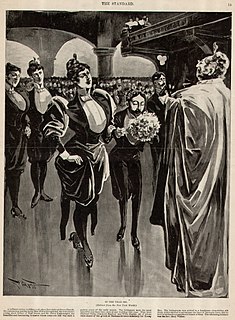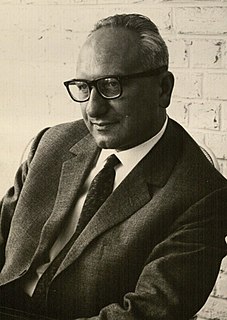
A false dilemma, also referred to as false dichotomy, is an informal fallacy based on a premise that erroneously limits what options are available. The source of the fallacy lies not in an invalid form of inference but in a false premise. This premise has the form of a disjunctive claim: it asserts that one among a number of alternatives must be true. This disjunction is problematic because it oversimplifies the choice by excluding viable alternatives. For example, a false dilemma is committed when it is claimed that, "Stacey spoke out against capitalism; therefore, she must be a communist". One of the options excluded is that Stacey may be neither communist nor capitalist. False dilemmas often have the form of treating two contraries, which may both be false, as contradictories, of which one is necessarily true. Various inferential schemes are associated with false dilemmas, for example, the constructive dilemma, the destructive dilemma or the disjunctive syllogism. False dilemmas are usually discussed in terms of deductive arguments. But they can also occur as defeasible arguments. Our liability to commit false dilemmas may be due to the tendency to simplify reality by ordering it through either-or-statements, which is to some extent already built into our language. This may also be connected to the tendency to insist on clear distinction while denying the vagueness of many common expressions.

A slippery slope argument (SSA), in logic, critical thinking, political rhetoric, and caselaw, is an argument in which a party asserts that a relatively small first step leads to a chain of related events culminating in some significant effect. The core of the slippery slope argument is that a specific decision under debate is likely to result in unintended consequences. The strength of such an argument depends on whether the small step really is likely to lead to the effect. This is quantified in terms of what is known as the warrant. This type of argument is sometimes used as a form of fearmongering in which the probable consequences of a given action are exaggerated in an attempt to scare the audience, although, differentiation is necessary, since, in other cases, it might be demonstrable that the small step will likely lead to an effect.

Determinism is the philosophical view that all events are determined completely by previously existing causes. Deterministic theories throughout the history of philosophy have sprung from diverse and sometimes overlapping motives and considerations. The opposite of determinism is some kind of indeterminism or randomness. Determinism is often contrasted with free will, although some philosophers claim that the two are compatible.
A fallacy is the use of invalid or otherwise faulty reasoning, or "wrong moves", in the construction of an argument, which may appear stronger than it really is if the fallacy is not spotted. Some fallacies are committed intentionally to manipulate or persuade by deception, while others are committed unintentionally due to carelessness or ignorance. The soundness of legal arguments depends on the context in which the arguments are made.

The problem of induction is the philosophical question of what are the justifications, if any, for any growth of knowledge understood in the classic philosophical sense—knowledge that goes beyond a mere collection of observations—highlighting the apparent lack of justification in particular for:
- Generalizing about the properties of a class of objects based on some number of observations of particular instances of that class or
- Presupposing that a sequence of events in the future will occur as it always has in the past. Hume called this the principle of uniformity of nature.
Scientific realism is the view that the universe described by science is real regardless of how it may be interpreted.
Inductive reasoning is a method of reasoning in which a body of observations is synthesized to come up with a general principle. Inductive reasoning is distinct from deductive reasoning. If the premises are correct, the conclusion of a deductive argument is certain; in contrast, the truth of the conclusion of an inductive argument is probable, based upon the evidence given.
Critical rationalism is an epistemological philosophy advanced by Karl Popper on the basis that, if a statement cannot be logically deduced, it might nevertheless be possible to logically falsify it. Following Hume, Popper rejected any inductive logic that is ampliative, i.e., any logic that can provide more knowledge than deductive logic. So, the idea is that, if we cannot get it logically, we should at the least try to logically falsify it, which led Popper to his falsifiability criterion. Popper wrote about critical rationalism in many works, including: The Logic of Scientific Discovery (1934/1959), The Open Society and its Enemies (1945), Conjectures and Refutations (1963), Unended Quest (1976), and The Myth of the Framework (1994).
"Two Dogmas of Empiricism" is a paper by analytic philosopher Willard Van Orman Quine published in 1951. According to University of Sydney professor of philosophy Peter Godfrey-Smith, this "paper [is] sometimes regarded as the most important in all of twentieth-century philosophy". The paper is an attack on two central aspects of the logical positivists' philosophy: the first being the analytic–synthetic distinction between analytic truths and synthetic truths, explained by Quine as truths grounded only in meanings and independent of facts, and truths grounded in facts; the other being reductionism, the theory that each meaningful statement gets its meaning from some logical construction of terms that refer exclusively to immediate experience.

Argumentation theory, or argumentation, is the interdisciplinary study of how conclusions can be reached from premises through logical reasoning. It includes the arts and sciences of civil debate, dialogue, conversation, and persuasion. It studies rules of inference, logic, and procedural rules in both artificial and real world settings.
Informal fallacies are a type of incorrect argument in natural language. The source of the error is not just due to the form of the argument, as is the case for formal fallacies, but can also be due to their content and context. Fallacies, despite being incorrect, usually appear to be correct and thereby can seduce people into accepting and using them. These misleading appearances are often connected to various aspects of natural language, such as ambiguous or vague expressions, or the assumption of implicit premises instead of making them explicit.
The barbershop paradox was proposed by Lewis Carroll in a three-page essay titled "A Logical Paradox", which appeared in the July 1894 issue of Mind. The name comes from the "ornamental" short story that Carroll uses in the article to illustrate the paradox. It existed previously in several alternative forms in his writing and correspondence, not always involving a barbershop. Carroll described it as illustrating "a very real difficulty in the Theory of Hypotheticals". From the viewpoint of modern logic it is seen not so much as a paradox than as a simple logical error. It is of interest now mainly as an episode in the development of algebraic logical methods when these were not so widely understood, although the problem continues to be discussed in relation to theories of implication and modal logic.
In philosophy, a formal fallacy, deductive fallacy, logical fallacy or non sequitur is a pattern of reasoning rendered invalid by a flaw in its logical structure that can neatly be expressed in a standard logic system, for example propositional logic. It is defined as a deductive argument that is invalid. The argument itself could have true premises, but still have a false conclusion. Thus, a formal fallacy is a fallacy where deduction goes wrong, and is no longer a logical process. This may not affect the truth of the conclusion, since validity and truth are separate in formal logic.

Chaïm Perelman was a Polish-born philosopher of law, who studied, taught, and lived most of his life in Brussels. He was among the most important argumentation theorists of the twentieth century. His chief work is the Traité de l'argumentation – la nouvelle rhétorique (1958), with Lucie Olbrechts-Tyteca, translated into English as The New Rhetoric: A Treatise on Argumentation, by John Wilkinson and Purcell Weaver (1969).
Logical truth is one of the most fundamental concepts in logic. Broadly speaking, a logical truth is a statement which is true regardless of the truth or falsity of its constituent propositions. In other words, a logical truth is a statement which is not only true, but one which is true under all interpretations of its logical components. Thus, logical truths such as "if p, then p" can be considered tautologies. Logical truths are thought to be the simplest case of statements which are analytically true. All of philosophical logic can be thought of as providing accounts of the nature of logical truth, as well as logical consequence.
Appeal to the stone, also known as argumentum ad lapidem, is a logical fallacy that dismisses an argument as untrue or absurd. The dismissal is made by stating or reiterating that the argument is absurd, without providing further argumentation. This theory is closely tied to proof by assertion due to the lack of evidence behind the statement and its attempt to persuade without providing any evidence.
The argument from reason is an argument against metaphysical naturalism and for the existence of God. The best-known defender of the argument is C. S. Lewis. Lewis first defended the argument at length in his 1947 book, Miracles: A Preliminary Study. In the second edition of Miracles (1960), Lewis substantially revised and expanded the argument.
The burden of proof is the obligation on a party in a dispute to provide sufficient warrant for its position.

Logic is the study of correct reasoning or good arguments. It is often defined in a more narrow sense as the science of deductively valid inferences or of logical truths. In this sense, it is equivalent to formal logic and constitutes a formal science investigating how conclusions follow from premises in a topic-neutral way or which propositions are true only in virtue of the logical vocabulary they contain. When used as a countable noun, the term "a logic" refers to a logical formal system. Formal logic contrasts with informal logic, which is also part of logic when understood in the widest sense. There is no general agreement on how the two are to be distinguished. One prominent approach associates their difference with the study of arguments expressed in formal or informal languages. Another characterizes informal logic as the study of ampliative inferences, in contrast to the deductive inferences studied by formal logic. But it is also common to link their difference to the distinction between formal and informal fallacies.






